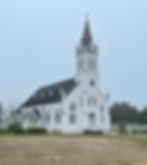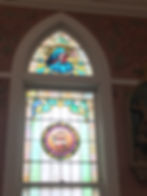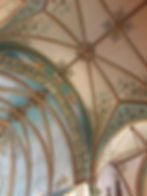The Painted Churches of Texas
- Hadia Mawlawi
- Apr 8, 2021
- 8 min read
Updated: Jul 8, 2021
On a recent cold February day, my good friend Lana and I ventured out to Schulenburg in Fayette County, TX to explore the Painted Churches.
We wanted to learn about the Czech immigrants who built them and settled in Texas in the mid 1800s.
Our day would be filled with surprises and new discoveries.
A little background

photo credit: Lana Rigsby
As with the Germans who came to Texas between 1844-1850, the Czechs were looking for religious freedom, economic opportunity, evasion of military conscription, and the promise of land, since they were small landowners who saw little opportunity for prosperity at home, which was still part of the Austro-Hungarian empire. In late August 1851, the first wave of Czech immigrants (16 families) began to arrive in Texas. Their long, circuitous, 17-week journey began in Bremen, Germany, continued to Liverpool (UK), New Orleans and finally Galveston, from where they continued to Houston by steamship. They loaded their children and belongings onto oxcarts and walked the 60 miles to Cat Spring in Austin, the point of dispersal for these immigrants which, according to a newcomer, was "not much more than a prairie and a heavy forest that was full of wildcats". The Central Texas counties of Austin, Fayette, Lavaca, and Washington had early Czech settlements, and Fayette County in particular became established as the center of Czech population in Texas. Dubina (Oak Grove in Czech), in Fayette County, saw roughly 600 Czechs settle there by the 1880's. Their population grew steadily and by 1910 there were more than 15,000 foreign-born Czechs in Texas, second only to Germans. The vast majority were Catholic.
The Czechs came mainly from villages in northern Moravia and Northeastern Bohemia, in what is now the Czech Republic. They were a hard-working farming community, who valued the close-knit family unit, and land, not just as a stream of revenue but as a way of life. They were determined to preserve their social and religious traditions, forming civic and fraternal societies and building schools and churches to maintain their language and customs. The beautiful interiors of the churches they built in Texas are a symbol of their eventual success as a farming community.
The painted churches
There are more than 20 painted churches across Texas built by the German and Czech settlers in the late 19th and early 20th centuries. The churches I will focus on here are the four I visited in Schulenburg County, approximately 95 miles west of Houston.
These painted churches embody the aspirations of the immigrant communities that built them, who had reached a certain level of success and wanted to build strong places of worship that reflected their economic prosperity. The community came together to pool their funds and hire the best painters and architects their money could buy. They wanted to build churches reminiscent of the ones in their homeland, designed in the classic gothic revival style.
Saints Cyril and Methodius Church- Dubina, TX

photo credit: Lana Rigsby
Upon approaching Saints Cyril and Methodius Church in Dubina, known as the "Mother of Czechs in Texas", I was immediately struck by its isolated location, about 10 minutes drive from Schulenburg. The imposing, yet unadorned structure of the church stood majestically amid wide open Texas fields that once was a thriving town with a school, a grocers store, a saloon and barber, a dance hall and bar, a courthouse and other buildings you would find in any thriving civic society. Today, all that is left is the church and vast pastures. I learned that the iron cross that tops the steeple was made by freed slave and blacksmith Tom Lee.
The unassuming exterior of the church did nothing to prepare us for what we would discover inside: Blue vaulted ceiling gleaming with gold stars, floral stenciling and angels, acorns, palm fronds and roses depicting the last week of Christ's life.

photo credit: Hadia Mawlawi- Interior view of Saints Cyril and Methodius Church
Even the profile of the pews were shaped as oak leaves. The church we see today is the second one built on this site: The first one was built in 1877 and destroyed in 1909 by a tornado. The current one, built in 1911, with its beautiful painting of scrolls and vines, has an altar brought from Italy in pieces and put together by the Czech carpenters in Dubina. In 1984, the church was listed on the National Register of Historic Places, along with the three churches described below. Saints Cyril and Methodius, AD 800, were two brothers who are credited with translating the gospel and liturgical books into old church slavonic, developing the earlier version of the Cyrillic alphabet and promoting the gospel in great Moravia. It makes sense therefore that the first wave of Czech immigrants would want to honor the brothers with this church.

photo credit: Hadia Mawlawi- Angels playing the lute and the harp
There are at least 3000 gold stars on the ceiling. Each star, with its six points, represents the six attributes of God: Love, Majesty, Justice, Wisdom, Mercy, and Power. The six points also represent the six days it took God to create the earth.

photo credit: Hadia Mawlawi- Oak leaf-shaped arm rest on pews- The oak leaf is a remnant of pagan iconography brought from Middle-Eastern Europe. It is Germany's national tree and is said to represent strength, nobility and knowledge.

photo credit: Hadia Mawlawi - view of the altar and wall stencils
St. John the Baptist Church- Ammansville, TX

photo credit: Lana Rigsby- Exterior view of St. John the Baptist Church

photo credit: Hadia Mawlawi
St. John the Baptist church is referred to as "The Pink One" for reasons you will soon discover.
It was built in 1919 and is the third church on this spot. The first was built in 1890 and destroyed by the 1909 tornado. The second church, built in 1910, burnt down in 1917. When the church was rebuilt, it was designed with no central column, which was revolutionary at the time and gives the church its beautiful open feel. Upon entering, you are immediately charmed by the rose-pink interior, decorative painting on the walls and ceiling, and the stained glass windows inspired by Tiffany stained glass, with its combined use of elaborate polychrome painting, texture, opalescent glass and rich tones.

photo credit: Hadia Mawlawi- The Latin inscription translates to "my delight is with the children of men" and comes from the Proverbs 8:31. Inside the arch is a grapevine, which is to remind attendees that He is the vine, and the people are the branches. The altars at the front of the church are white and gold, which is a Czech tradition.

photo credit: Hadia Mawlawi

photo credit: Hadia Mawlawi
Different decorative painting styles are used to embellish the walls: Stencilling, marbling (see the column painted to imitate marble), infill and pounce-painting: a technique in which silk fabric was placed on the ground and paint "pounced" on it through another layer of silk- the fabric was then glued to the wall or ceiling.
Nativity of Mary, Blessed Virgin Catholic Church- High Hill TX

photo credit: texasescapes.com
Unlike the previous two churches, this one was built by German immigrants and is known as "The Queen of the Painted Churches". Its exterior is built from brick, making it resistant to fires and storms, a request imposed on the architect by the church leadership of the time.

photo credit: Hadia Mawlawi- The names on the bottom of the windows are the names of the families who sponsored each window.
The first church was built in 1869, the second, larger church was built in 1876 and featured the addition of stained-glass windows imported from Europe which were built in 1899 and stored in a barn until they were able to be moved into the newest and largest building which was built in 1906 and painted in 1912. The current church was built by renowned architect Leo Dielman, specifically for the small German settlement of High Hill. The abundance of interior decorative paintings were added in 1912 by Ferdinand Stockert and Hermann Kern, and restored in 2011. The church is a classic example of the gothic revival style , and its interior is richly decorated with intricate stained glass windows, numerous statues of saints and biblical figures, and wall and ceiling decorative painting. Bible verses in German are painted on the walls.

photo credit: Hadia Mawlawi- This picture shows the statues of the many saints mounted on pillars, with the male on the right of the center aisle and the females on the left- This is also how the congregation divided up when attending services: women sat in the pews on the left and men sat on the right.
The light blue wash and scrollwork is not actually painted on the ceiling but on canvas that was attached to the wooden ceiling. Faux-marble finish on the hollow wooden pillars is painted with turkey feathers to emulate real marble and the ceiling design is inspired by the work of William Morris whose arts and craft movement had a far-reaching influence.

photo credit: Hadia Mawlawi
The symbol of the lying lamb that can be seen in the image above represents the suffering and burden-carrying of Jesus. He carries a white flag with a red cross symbolizing resurrection. Symbols abound in these churches as do finely fitted woodwork.

photo credit: Lana Rigsby
I particularly liked the symbolism behind this image: A female pelican pecks herself on her chest during droughts to feed her chicks who would otherwise die of thirst-a symbol of Christ feeding his people during times of famine.
St. Mary's Church of the Assumption- Praha

photo credit: Kyle G. Sweeney
This church was built in 1895 and is the oldest of the four famous painted churches in Fayette County. It is located in Praha which used to be a very prosperous town due in part to cotton farming. It was once part of old Mexico but today, it is all but a ghost town. The church was the first Catholic church in Texas with a predominantly Czech congregation. Over 200 Czech families lived in the area. The small yellow-stone church, made with stone from a quarry 20 miles away in Muldoon, is built in the Gothic Revival style, with a steeple and windows pointing to God. The interior painting is done by Swiss-born artist Gottfried Flury and the ceiling is largely made out of ship lap .

photo credit: Hadia Mawlawi- Interior altar
Lush foliage in bright turquoise, emerald greens and blues overwhelm the senses upon entry. It's not what you expect when approaching the modest brick exterior structure. Flowers, palms, and stars abound on the ceiling and walls and the white altar is gilded in 24 karat gold.

photo credit: Hadia Mawlawi- Swiss artist Gottfried Flury lay on his back and painted the Garden of Eden depicting Texas Botanicals on the church's ceiling.

photo credit: Lana Rigsby
Acorns and oak leaf designs adorn the walls, symbols passed on from the Druid tradition. The figures on the altar are made from wood of the Black Forest.

photo credit: Lana Rigsby- The doors of the church are painted with portraits of St. Peter, St. Paul, St. Cyril, and St. Methodius

photo credit: Lana Rigsby- View of the door panels from the interior with two angels status flanking each side. The pink signifies humanity and the blue, divinity.

photo credit: Lana Rigsby- The original St. Mary's School adjacent to the church
The Boys of Praha

photo credit: Lana Rigsby
During WWII the hamlet of Praha lost the most men per capita of any town in the US- only 80 people lived here and 9 of them were killed in the war. The Praha Cemetry which was dedicated in 1865 is home to a monument that honors eight of the men who lost their lives in the battlefields. The ninth is buried at sea.

photo credit: Lana Rigsby- Every year, on the Sunday before Veteran's Day in November, a service is held in remembrance of these men, now referred to as "The Boys of Praha".
For more information on the Painted Churches of Texas visit:
Tours of the painted churches can be booked by contacting the Schulenburg Chamber of Commerce: +1(979)- 743 4514
With very special thanks to Lana Rigsby for her contributions to this post.
Don't forget to post your comments and share your thoughts!